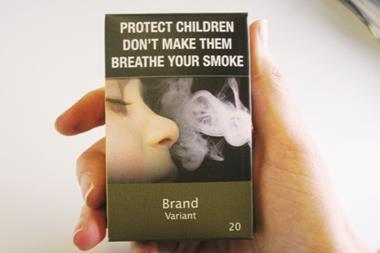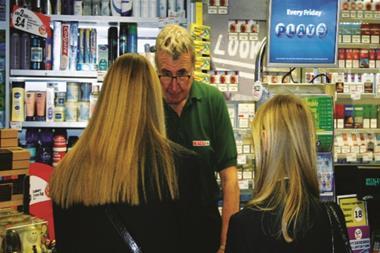The government has exteneded its consultation on plain packaging by one month until Friday 10th August 2012.
Explaining the decision, health minister Anne Milton said: “We have an open mind about the introduction of standard packing and want to take full account of all views on the possible benefits and disadvantages of action in this area.
“We have received thousands of responses to the consultation already but we want to make sure that everyone who wants to contribute can.”
Meanwhile, in Convenience Store’s recently-submitted response to the consultation, we explain how the move would damage efficiency, profitability and sales in the local shop industry, as well as potentially damaging tax revenues by encouraging the illicit trade and downtrading in the legitimate tobacco market by destroying brand equity.
Our submission (outlined below) also outlines how the government’s own statistics show that the factors most likely to encourage children to take up smoking are environmental, rather than being related to brand packaging or displays.
Consultation on Standardised Packaging of Tobacco Products
Submission by Convenience Store
Introduction
Convenience Store is the market leading fortnightly magazine and website for convenience store owners and operators. The stated strategy and raison d’etre of the brand is to support, defend and campaign for independent convenience store operators. This submission to the consultation is a personal view by the editor, David Rees, following consultation with independent store owners.
Effect of standardised packaging on the retail industry
Standardised packaging would be costly, subject to error and hugely inefficient to introduce into the UK retail industry.
The complete lack of brand recognition in a typical tobacco gantry would create significant delays in serving customers, and with all customers served at the same till point, this would affect all customers, not just those buying tobacco. Within the convenience store industry specifically, speed of service is cited by 14% of customers as the main reason that they visit a particular convenience outlet on a particular day (HIM Convenience Tracking Programme, April 2012). The loss of these customers to other outlets where staffing or shopping structures are different is potentially catastrophic for the industry.
Packs without brand indicators would also add delay and cost throughout the supply chain for tobacco products, whether the retailer self-selects products in a cash & carry environment, or has stock delivered by a wholesaler, as more time would be required to check the correct stock is ordered and delivered. This will have a huge cost in terms of man-hours and efficiency.
The potential for errors in purchasing, restocking the gantry or mistakenly selling the customer the wrong product will also increase markedly. With the large cash value and low percentage profit margin inherent with tobacco products, the financial consequences of each error are serious, and so the risk to the financial wellbeing of retail businesses is significant.
Additionally, increased costs in the form of additional staffing, more time spent checking deliveries and increased errors could potentially result in compensatory retail price increases, which would affect all shoppers, not just smokers.
The above points represent a disproportionately high burden to smaller businesses compared to larger multiple competitors. Independently-owned retail outlets, unable to obtain the equivalent buying prices for goods enjoyed by large multiple operators, have successfully embraced high levels of customer service and have tackled overhead costs and improved efficiency in order to maintain viability as businesses. Standardised tobacco would undermine efforts in all three areas.
The need to be sympathetic towards small businesses with tobacco regulation has already been acknowledged and accepted by parliament with a phased introduction of the tobacco retail display ban, with smaller outlets given an additional three years to comply. The introduction of generic tobacco packaging, which by definition would be on a blanket basis, would jettison this principle completely.
For context, the proportion of UK convenience stores that are in small business ownership (ie operated by companies owning nine outlets or fewer) is 87%.
Effect of standardised packaging on young people
No evidence, anywhere in the world, exists to either prove or disprove the assumption that standardised packaging will, in itself, lead to a reduction in the adoption of tobacco products by young people.
Standardised packaging is scheduled to be introduced in Australia in December 2012, the first nation state to do so. There will be no international experience or precedent to draw conclusions from until after this date.
Any estimate or projection about a reduction in the adoption of smoking by young people as a result of standardised packaging in the meantime is merely guesswork. Therefore the government needs to be extremely careful not to over-estimate the impact of standardised packaging on smoking adoption while under-estimating the negative impact on tax revenues and the business community. Anything else would be reckless and irresponsible stewardship of the UK economy.
There are studies available which have shown that children respond to bright and attractive packaging. Any parent would say that they already knew this to be the case without having to undertake a study. But it does not follow that any particular subject who is attracted to a brightly coloured pack as a child will become a smoker many years later. All fmcg products are packaged in such a way as to reflect their brand equity and to encourage purchase over competitor products, but the choice as to whether young adults smoke, become a vegetarian or opt for a particular brand of clothing or footwear over others in the marketplace remains their own.
The UK government already collects comprehensive data about smoking among young people, and it is surely a sensible course to use this information as the basis for any new regulation aimed at reducing consumption and take up of tobacco products by children.
The annual NHS study ‘Smoking, Drinking and Drug use Among Young People in England’ shows that the proportion of school age children who have ever smoked is in continual long-term decline under the existing tobacco control regime. In 2010 only 27% of pupils had ever smoked, compared to 53% in 1982.
The main factors influencing whether a young person becomes a smoker or not, according to the report, are environmental. Namely: the smoking behaviour of families and friends, and whether the subject lives in a household with other smokers. Packaging design is not mentioned as a factor.
Smoking is also highlighted within the study as being associated with (other) risky behaviour, with pupils who smoke more likely to also drink alcohol, consume drugs and be excluded from school. With this in mind, any further measures to de-legitimise the sale of tobacco and drive it ‘underground’ would arguably only increase its appeal to the group of youngsters who show the highest propensity to smoke in the first place.
The purpose of tobacco packaging
To restate an earlier paragraph, the proportion of school age children who have ever smoked is in continual long-term decline. In 2010 only 27% of pupils had ever smoked, compared to 53% in 1982.
This needs to be viewed alongside the development in packaging for tobacco products. Production technology has advanced in such a way as the packaging for tobacco in the UK today is more colourful, varied, detailed and intricate than ever before. Indeed, this trend was cited and largely accepted by MPs as important evidence in the recent debate regarding the introduction of a retail display ban on tobacco products.
Yet smoking rates overall, and trial of smoking by school age children, is at an all-time low. So it runs counter to normal logic to assert that there is a causal link between packaging attractiveness and adoption of smoking, and it is impossible for any rational person to draw the conclusion that brand packaging for tobacco products is an important factor in the adoption of smoking by young people.
It has been claimed that the tobacco packet is the only means available to manufacturers to ‘recruit’ the next generation of smokers. Yet, as well as the unprecedented intricacy of tobacco packaging, there is also greater variation than ever before in terms of colours, designs and additional features such as flip-top lids and slide release systems. If the primary purpose of packaging was to ‘recruit’ smokers, it would be expected that there would be more uniformity in packaging, as the focus would be on highlighting the key features that most appealed to potential new smokers, rather than the widely varied and intricate brand differentiators present in the UK market today.
The primary and, it can be argued, sole purpose of tobacco packaging is an expression of brand value, to differentiate the product from other brands in the marketplace. The more expensive the retail price of the brand, and the more equity in that brand in terms of national sales value, the more resources are dedicated to the packaging of the product by the manufacturer. This rule applies in all FMCG product categories, not just tobacco.
For this reason, there is an additional and significant threat to UK tax revenues from a change to standardised packaging.
Removing packaging differentiators would remove all equity and value from tobacco brands. With no advertising or visible branding, there would be no way for manufacturers to maintain a higher price point for premium brands compared to economy lines, and smokers would be highly likely to switch to cheaper products.
According to the Tobacco Manufacturers’ Association website, UK tax revenue from tobacco in 2011-12 was made up from £9.5bn in excise and £2.6bn in VAT, meaning VAT accounts for over 21% of the UK tax take from tobacco. This compares to an 18% share in 1998-99. Widespread switching from premium to economy brands within the UK tobacco market would restrict the tax revenues to be earned from VAT, irrespective of any decision the government were to make on excise duty rates.
Illicit trade
I am sure I am not alone in raising the threat that the illicit tobacco trade poses to the UK retail industry and to the UK taxpayer. I will leave it to other organisations to supply projections as to the loss of UK tax revenue due to smuggled, cross-border purchased and counterfeit tobacco.
Branding is a source of trust for consumer purchases. Removing the branding from tobacco would remove a key element of consumer trust in the product, meaning there would be no visible distinction between a commercially-produced product, complying with ingredient and labelling legislation, on sale in a tax-registered retail outlet, and more hazardous product produced in unsafe conditions and sold on a street corner by a criminal with no tax revenue benefit to the UK Treasury.
While it is true that professional criminal networks have already successfully produced counterfeit versions of the UK’s leading brands, there is no sensible reason why the UK government should choose to make it cheaper and simpler for counterfeit gangs to operate. Unlike the legitimate retail trade, illicit counterfeit networks will make no distinction regarding the age of purchasers. So by boosting the activity of illicit tobacco networks, it is conceivable that standardised packaging could actually increase youth access to tobacco, quite apart from undermining tax revenues.
Conclusion
In summary, the introduction of standardised packaging would:
1) Impair efficiency, profitability and service levels in every retail outlet involved in the sale of tobacco
2) Have a disproportionate impact on smaller, independently owned businesses
3) Eliminate brand equity in the legitimate tobacco market, to the detriment of UK tax revenues
4) Facilitate higher levels of counterfeiting and illicit tobacco trading, to the detriment of UK tax revenues, youth access to tobacco and public health
To balance this, there is no evidence that the introduction of standardised packaging in itself would have any impact at all on the numbers of young people taking up smoking. As such, to proceed with the proposal can only be viewed as an unsubstantiated and reckless risk to the small business community and the UK taxpayer.
Footnote:
Relationship with the tobacco industry
Convenience Store is a commercial publishing brand, covering print and electronic publishing and live events. It is part of the WRBM media group, and is independent of any external organisation.
Advertising and event sponsorship represent important commercial revenue streams, and advertising and event sponsorship from tobacco manufacturers is both accepted and encouraged. However, the tobacco category is only one of 48 product and equipment categories covered in detail by Convenience Store in an average calendar year, and commercial relationships exist with advertisers and potential advertisers in each of these 48 categories.
David Rees
Editor,
Convenience Store
William Reed Business Media
Broadfield Park
Crawley
West Sussex
RH11 9RT
David.rees@wrbm.com
2/7/12


























1 Readers' comment